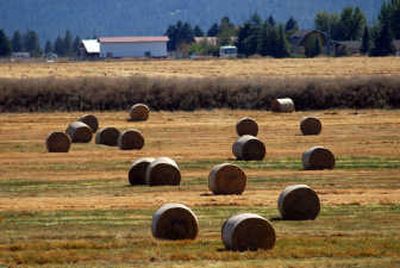Burn ban brightens outlook

Something’s missing in the skies above the Rathdrum Prairie this August: smoke.
Because of a recent federal court ruling, no bluegrass fields on the prairie are being burned for the first time in a generation.
Vivian Evans, a Rathdrum grandmother who has severe asthma, said the lack of smoke has brought dramatic changes to her summertime routine.
“I can go out. I can go fishing. I can take my grandkids to the park. I can actually work in my flower garden and do things I haven’t been able to do for 30 years,” said Evans, a plaintiff in the lawsuit that resulted in the ban on crop residue burning in Idaho.
The ruling earlier this year by the 9th U.S. Circuit Court of Appeals did not halt burning on Indian reservations. The Nez Perce Tribe in north-central Idaho began field burning Monday. Burning has not yet begun on the Coeur d’Alene Reservation because of heightened fire restrictions, said Alieene “Boom” George, smoke management program coordinator for the tribe.
George said acreage estimates for the upcoming burn would not be available until after the fire restrictions are eased.
The restrictions are not likely to be lifted until mid-September, when fall rains and cooler temperatures typically return to North Idaho, said Gail West, spokeswoman for the Idaho Panhandle National Forests.
Farmers burn their bluegrass fields late in the summer to clear the fields and spur new growth in perennial bluegrass plants. Without burning, farmers say their yields drop by 75 percent and they must resort to expensive fertilizers and soil-disturbing tillage practices.
But the smoke created by bluegrass is loaded with tiny particles that are dangerous to people with breathing problems, said Patti Gora, executive director of Safe Air For Everyone, a Sandpoint-based group that partnered with the American Lung Association of Idaho to file the lawsuit that ultimately ended the practice outside reservation lands in Idaho. At least two deaths in the last five years are blamed on smoke from field burning, according to the lawsuit.
Field burning became common on the Rathdrum Prairie north of Coeur d’Alene in the early 1970s. Since then, the thick plumes of brown smoke have been an annual rite of North Idaho summers.
In the early 1990s, upward of 12,000 acres were burned on the prairie each summer. Last year, about 2,400 acres were burned, according to previously published reports.
Safe Air For Everyone is now in mediation with Idaho over its Clean Air Act implementation plan – an issue at the core of the field burning dispute. Gora said talks have only recently begun, but she said her group might find field burning acceptable if Idaho follows a plan similar to one adopted recently by Washington.
“Nobody is being hurt, nobody is being sent to the hospital, nobody has died,” Gora said, referring to Washington’s program, which allows field burning only under strict circumstances.
Evans, who moved to North Idaho in 1972, said she sympathizes with farmers but doesn’t think field burning should ever again be allowed on the Rathdrum Prairie because of the high number of homes in the area.
“I never want a farmer to stop farming, but I don’t think they should be allowed to endanger people’s lives,” Evans said.
For now, Evans is just trying to enjoy her first smoke-free August in three decades. She’s even taken to sleeping with the windows open.
“This is just fantastic,” she said. “I can’t believe it’s true.”